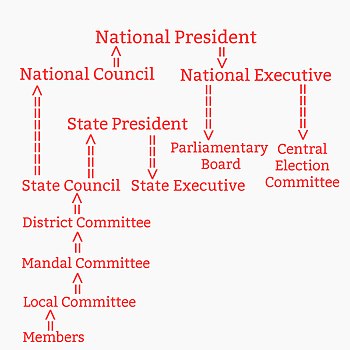Organisation of the Bharatiya Janata Party
The organisation of the Bharatiya Janata Party (BJP) is based upon the Constitution of the Bharatiya Janata Party.[1] The organisation of the BJP is strictly hierarchical, with the president being the highest authority in the party. The party is considered to be a cadre-based party that draws from the Hindutva-based ideology of its parent organisation, the Rashtriya Swayamsevak Sangh.[2][3]

As of 2019, it is the country's largest political party in terms of representation in the national parliament and state assemblies and is the world's largest party in terms of primary membership.[4]
National level organisation
President
The organisation of the BJP is strictly hierarchical, with the president being the highest authority in the party.[5] According to the party's constitution, the president is elected by an electoral college compromising of the National Council and the State Councils. Until 2012, the BJP constitution mandated that any qualified member could be national or state president for a single three-year term.[5] This was amended to a maximum of two consecutive terms.[6]
National Executive
Below the president is the National Executive, which contains a variable number of senior leaders from across the country appointed by the President of the party. It is the higher decision making body of the party. It consists of several office holders of the party, including upto seven vice- presidents, upto five general secretaries, one general secretary (organisation), one treasurer and upto seven secretaries who work directly with the president.[5] An identical structure, with an executive committee led by a president, exists at the state, regional, district and local level.[5]
National Council
The National Council is the highest policy making body of the party. It is also responsible for rectification of any amendment, alteration and addition to the party constitution by National Executive in the following Plenary Session or Special Session. The National Council along with the State Council also elects the President every three year. The National Council consists of members that are elected by the State Councils, 10% of the parliamentary party, former national Presidents, leaders of state legislative assemblies and state legislative councils, members nominated by the national president, all members of the National Executive, presidents of Morchas and Cells.[1]
State level organisation
Grassroot level organisation
Membership
— Bharatiya Janata Party membership pledge[1]
Any Indian citizen of the age of 18 years or above can become a member of the Party, provided that he is not a member of any other political party. The term of membership will ordinarily be of 6 years.[1] As of 2019, it is the world's largest political party in terms of primary membership.[4]
See also
References
Citations
- "Bharatiya Janata Party Constitution". BJP official website. Bharatiya Janata Party. Archived (PDF) from the original on 18 November 2017. Retrieved 15 May 2020.
- Ram Madhav (April 6, 2018). "Leader, cadre, parivar". indianexpress.com. Indian Express. Retrieved 8 August 2020.
- Gyan Varma (2 December 2014). "BJP 2.0: A mass-based political party". livemint.com. Live Mint. Retrieved 8 August 2020.
- "BJP inducts 7 crore new members, creates membership drive record". India Today. 29 August 2019. Retrieved 29 August 2019.
- Swain 2001, pp. 71–104.
- Times of India 2012.
Sources
- Swain, Pratap Chandra (2001). Bharatiya Janata Party: Profile and Performance. India: APH publishing. pp. 71–104. ISBN 978-81-7648-257-8. Retrieved 5 July 2014.CS1 maint: ref=harv (link)